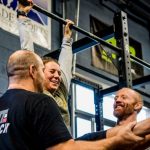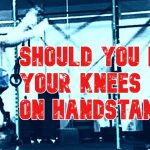Kipping? Or Strict?
Over the years, one of the biggest debates we’ve seen with regard to gymnastics skills comes down to strict vs kipping. Is one style a prerequisite for the other? Which is better? Is kipping dangerous? Is it “cheating?” Let’s settle this.
“Strict Gymnastics Must Come First!”
We’ll go ahead and tackle this one first. We’ve seen countless social media posts from countless coaches proclaiming that an athlete must have a baseline level of strict strength before they even think about kipping.
“Don’t start kipping your pullups until you can do [x number] of strict ones!”
“Learn a strict ring muscleup first before you even attempt kipping!”
“Butterfly pullups will destroy your shoulders unless you can already do twenty strict pullups!”
Hogwash.
Strict and kipping movements go hand-in-hand, and a knowledgeable gymnastics coach will teach both. At i99 Fit, we teach strict and kipping as parallel pathways. They complement each other and make athletes more complete, more strong, and healthier.
Let’s use some examples to drive the point home: Imagine a young child who has just walked into a gymnastics gym for the first time. That little boy or girl will start learning both kipping and strict skills on Day One, and will keep learning both for their entire gymnastics career. A five-year-old boy will get on the rings his first day and start learning the basics of how to hang and swing, and how to start building toward strict skills, like ring muscleups. He might not even be strong enough to do a pullup by himself for a couple of years.
A four-year-old girl will get on the bars her first day and work a variety of swinging and pulling skills–glide swings, tap swings, pullovers, and the like. She may not be strong enough to do an unassisted pullover for a couple of years. But both of these hypothetical young athletes will be training strict and kipping skills, together, forever, right from the get-go.
Applying this to the adult functional fitness athlete, strict and kipping work in conjunction with each other. Just about every athlete in a functional fitness environment can safely and effectively learn how to hang and kip on the rings and bars from the very beginning, because kipping is infinitely scaleable via drills. We can take anyone and teach them the basics of kipping in just a few minutes, at whatever level they’re safely able to handle. The same applies to strict strength work. The issue, primarily, is that there’s a lack of knowledge from many coaches about how and when to use each.
“Kipping Isn’t Real Gymnastics!”
Uh…yes. Yes, it is. We’ve seen this statement before, and frankly, we don’t get it. Watch any ring routine from the Olympics and you’ll see a mix of incredible strict strength and mind-blowing dynamic swinging skills. Watch a high bar or uneven bars routine and you’ll see pretty much nothing but swinging.
So why do so many in the strength and fitness industry insist that the only “real” pullups are strict pullups? Or that kipping ring muscleups are “cheating?” There’s plenty of room for both, and as an athlete, you should be training both. Strict pullups are awesome. Strict ring muscleups are awesome. So are kipping pullups, butterfly pullups, and kipping ring muscleups. They all have their place in human movement–the ability to be strong, dynamic, coordinated, and mobile makes you a better overall athlete and more capable of handling anything that life throws your way.
But again, many coaches and athletes don’t understand that strict and kipping movements are all tools in the fitness toolbox, and don’t know which tool to use for which job.
“Kipping Will Destroy Your Shoulders!”
This phrase is the “Squats will destroy your knees” of the gymnastics realm. Sure–crappy squats done with improper weight and technique probably will ruin your knees. But great squats are great for your knees, and strength and mobility in general.
Kipping works the same way–properly-done kipping skills are no more dangerous than any other movement you’ll do in the gym. In fact, we’re now starting to see things like relaxed bar hangs and gentle, relaxed kipping movements be recommended for shoulder health and rehab in people with recent shoulder injuries. The key is learning how to properly kip with relaxed shoulders.
“Active shoulders” is a great (and necessary) cue for strict skills. But for kipping, the ability to relax and to let your shoulder joints function the way they’re designed, as a ball-and-socket, is the key to both efficiency and joint health. The technique of relaxing during kipping is important to learn, and can be taught to anyone who has the physical ability to hang from the rings or a bar.
So…Kipping or Strict?
The answer is: “both!” If you want to be a healthier, stronger, more complete athlete, you should be working strict skills and kipping skills concurrently. Strict and kipping pullups, muscleups, handstand pushups, and other skills all have their place. Want to learn how to do both, or coach both, effectively? We’ve got you covered!



